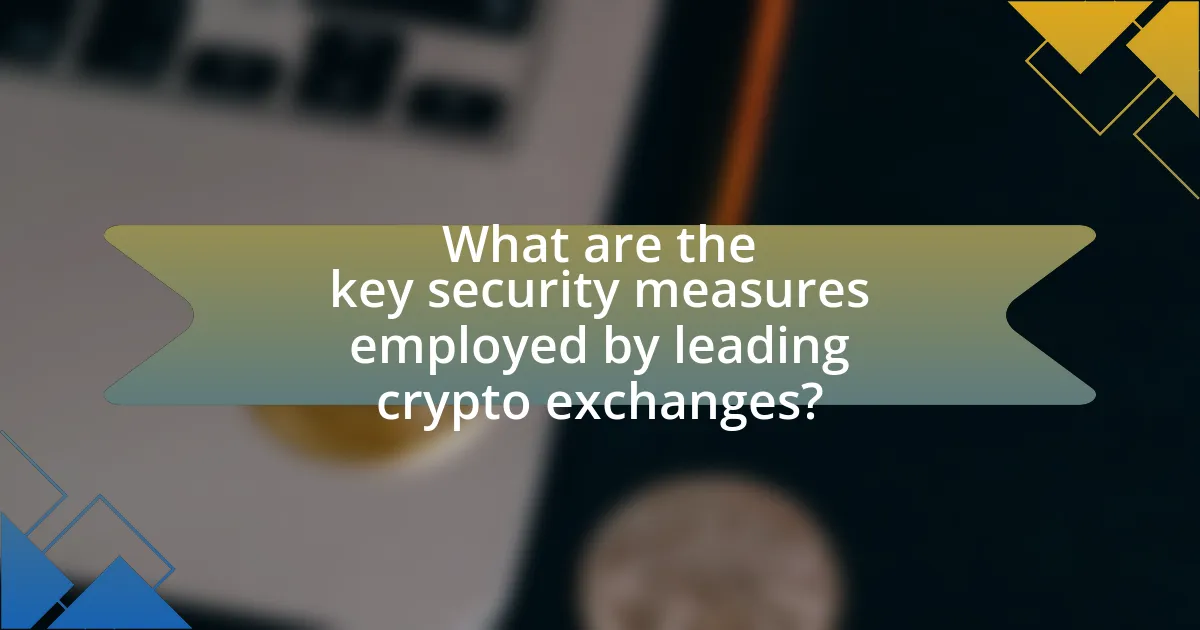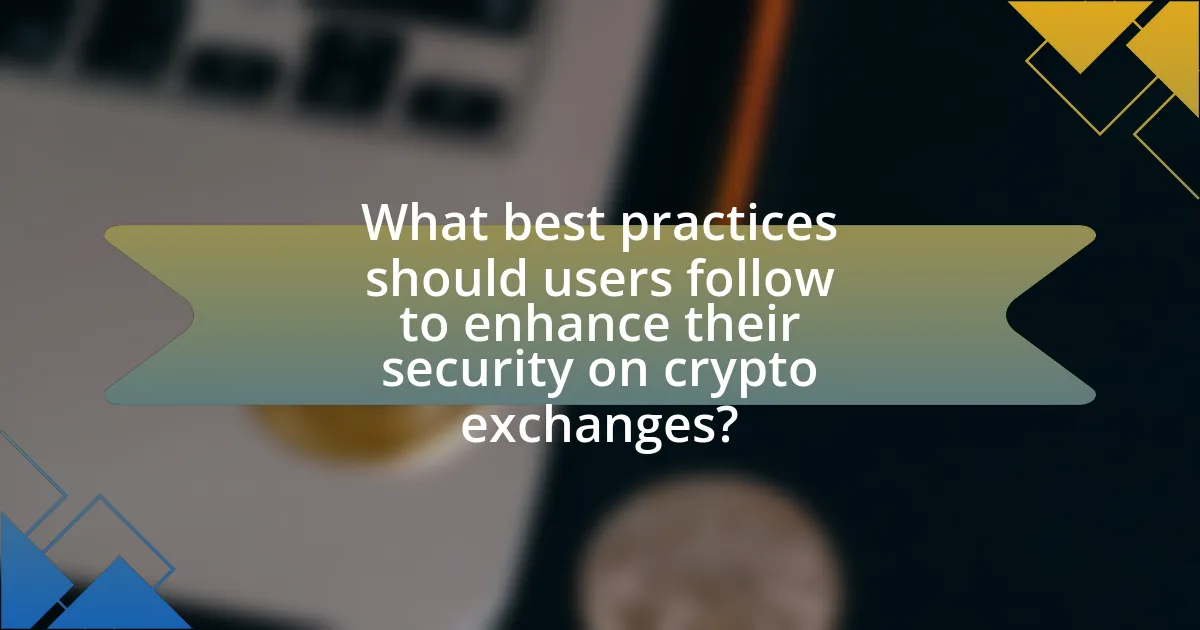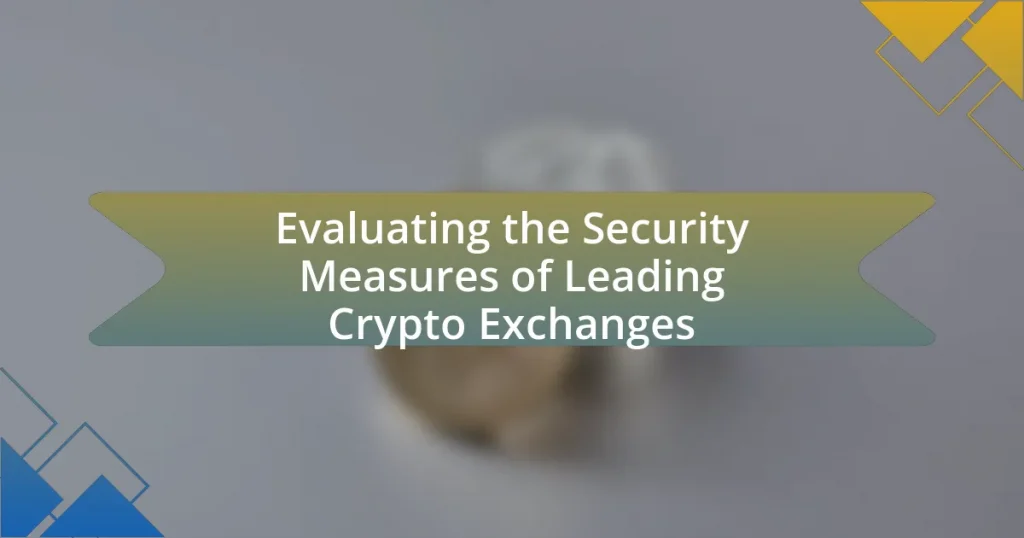The article evaluates the security measures employed by leading crypto exchanges to protect user assets and data. It outlines key protocols such as two-factor authentication (2FA), cold storage, encryption, and compliance with regulatory standards like Know Your Customer (KYC) and Anti-Money Laundering (AML) policies. The discussion includes how these measures mitigate risks from hacking, phishing attacks, and DDoS incidents, as well as the implications of non-compliance with security regulations. Additionally, it highlights best practices for users to enhance their security and safeguard their investments in the cryptocurrency space.

What are the key security measures employed by leading crypto exchanges?
Leading crypto exchanges employ several key security measures to protect user assets and data. These measures include two-factor authentication (2FA), which adds an extra layer of security by requiring users to provide two forms of identification before accessing their accounts. Additionally, many exchanges utilize cold storage for the majority of their digital assets, keeping them offline to mitigate the risk of hacking.
Furthermore, regular security audits and penetration testing are conducted to identify and address vulnerabilities in the system. Encryption protocols are also implemented to secure data transmission and storage, ensuring that sensitive information remains confidential. Finally, compliance with regulatory standards, such as Know Your Customer (KYC) and Anti-Money Laundering (AML) policies, helps to enhance security by verifying user identities and monitoring transactions for suspicious activity. These measures collectively contribute to a robust security framework that protects both the exchange and its users.
How do these security measures protect user assets?
Security measures protect user assets by implementing protocols such as encryption, multi-factor authentication, and cold storage. Encryption secures sensitive data during transmission and storage, making it difficult for unauthorized parties to access user information. Multi-factor authentication adds an extra layer of security by requiring users to verify their identity through multiple methods, significantly reducing the risk of unauthorized access. Cold storage, which involves keeping the majority of funds offline, minimizes exposure to online threats, thereby safeguarding user assets from hacking attempts. These measures collectively enhance the overall security framework of crypto exchanges, ensuring that user assets remain protected against various cyber threats.
What role does encryption play in securing transactions?
Encryption plays a critical role in securing transactions by converting sensitive data into a coded format that can only be read by authorized parties. This process protects information such as credit card numbers and personal identification from unauthorized access during transmission. For instance, the use of Advanced Encryption Standard (AES) ensures that data remains confidential and integral, as it is widely recognized for its strength and efficiency in safeguarding digital communications. Additionally, encryption protocols like SSL/TLS are employed by crypto exchanges to establish secure connections, further enhancing the security of transactions by preventing eavesdropping and tampering.
How do multi-signature wallets enhance security?
Multi-signature wallets enhance security by requiring multiple private keys to authorize a transaction, thereby reducing the risk of unauthorized access. This mechanism ensures that even if one key is compromised, the funds remain secure as additional keys are needed for transaction approval. For instance, a common configuration might require three out of five keys to sign a transaction, which significantly mitigates the risk of theft or fraud. This approach is supported by the fact that multi-signature wallets are widely adopted in the cryptocurrency industry, with platforms like BitGo and Coinbase utilizing this technology to protect user assets.
What are the common vulnerabilities faced by crypto exchanges?
Crypto exchanges commonly face vulnerabilities such as hacking, insider threats, and regulatory compliance issues. Hacking incidents have led to significant losses; for instance, the Mt. Gox exchange lost approximately 850,000 Bitcoins due to a security breach in 2014. Insider threats can arise from employees exploiting their access to sensitive information, which can compromise user funds and data. Additionally, regulatory compliance issues can expose exchanges to legal risks if they fail to adhere to evolving regulations, potentially resulting in fines or operational shutdowns. These vulnerabilities highlight the critical need for robust security measures in the crypto exchange industry.
How can phishing attacks compromise exchange security?
Phishing attacks can compromise exchange security by tricking users into revealing sensitive information, such as login credentials and private keys. These attacks often involve fraudulent emails or websites that mimic legitimate exchanges, leading users to unknowingly provide their information to attackers. According to the Anti-Phishing Working Group, there were over 200,000 unique phishing attacks reported in a single quarter of 2021, highlighting the prevalence of this threat. When users fall victim to phishing, attackers can gain unauthorized access to their accounts, facilitating theft of funds and personal data, thereby undermining the overall security of the exchange.
What impact do DDoS attacks have on exchange operations?
DDoS attacks significantly disrupt exchange operations by overwhelming servers with excessive traffic, leading to service outages and degraded performance. These attacks can result in financial losses for exchanges due to halted trading activities and potential damage to their reputation. For instance, in 2018, the cryptocurrency exchange Bitgrail suffered a DDoS attack that caused significant downtime, impacting user trust and trading volume. Additionally, exchanges may incur increased operational costs as they implement enhanced security measures to mitigate future attacks, further affecting their overall efficiency and profitability.

How do regulatory frameworks influence the security measures of crypto exchanges?
Regulatory frameworks significantly influence the security measures of crypto exchanges by establishing compliance requirements that mandate specific security protocols. For instance, regulations such as the Financial Action Task Force (FATF) guidelines require exchanges to implement Know Your Customer (KYC) and Anti-Money Laundering (AML) measures, which enhance user verification processes and transaction monitoring. Additionally, jurisdictions like the European Union enforce the General Data Protection Regulation (GDPR), compelling exchanges to adopt stringent data protection measures to secure user information. These regulatory mandates lead to increased investment in cybersecurity infrastructure, including multi-factor authentication and cold storage solutions, thereby improving overall security posture.
What regulations are most relevant to crypto exchange security?
The regulations most relevant to crypto exchange security include the Financial Action Task Force (FATF) guidelines, the General Data Protection Regulation (GDPR), and the Securities and Exchange Commission (SEC) regulations. FATF guidelines mandate that exchanges implement Anti-Money Laundering (AML) and Know Your Customer (KYC) protocols to prevent illicit activities. GDPR establishes data protection standards that require exchanges to secure user data and ensure privacy. SEC regulations govern the trading of securities, impacting exchanges that list tokens classified as securities, thereby enforcing compliance with security measures. These regulations collectively enhance the security framework of crypto exchanges by addressing financial crime, data protection, and market integrity.
How do KYC and AML policies enhance security?
KYC (Know Your Customer) and AML (Anti-Money Laundering) policies enhance security by verifying the identities of users and monitoring transactions for suspicious activities. These measures help prevent fraud, money laundering, and terrorist financing by ensuring that exchanges know who their customers are and can track their financial activities. For instance, a study by the Financial Action Task Force (FATF) indicates that effective KYC and AML practices can significantly reduce the risk of financial crimes in the cryptocurrency sector, thereby increasing overall trust and security in digital transactions.
What are the implications of non-compliance with security regulations?
Non-compliance with security regulations can lead to severe legal and financial repercussions for organizations. Companies may face hefty fines, which can amount to millions of dollars, as seen in cases like the $5 billion fine imposed on Facebook for privacy violations. Additionally, non-compliance can result in reputational damage, leading to loss of customer trust and a decline in business. For instance, the Equifax data breach in 2017, attributed to non-compliance with security standards, resulted in a significant drop in stock value and ongoing litigation costs. Furthermore, organizations may also encounter operational disruptions, as regulatory bodies may impose restrictions or sanctions that hinder business activities.
How do exchanges respond to security breaches?
Exchanges respond to security breaches by implementing immediate measures to secure their systems, notifying affected users, and conducting thorough investigations. Following a breach, exchanges typically freeze trading activities to prevent further unauthorized access and assess the extent of the damage. They also communicate transparently with users about the breach, detailing the steps being taken to mitigate risks and protect assets. For instance, after the 2014 Mt. Gox hack, the exchange filed for bankruptcy and initiated a recovery process for affected users, highlighting the importance of user communication and asset recovery in response strategies.
What incident response strategies are commonly implemented?
Commonly implemented incident response strategies include preparation, detection and analysis, containment, eradication, recovery, and post-incident review. Preparation involves establishing an incident response plan and training staff, which is crucial for effective response. Detection and analysis focus on identifying and assessing incidents through monitoring tools and threat intelligence. Containment strategies aim to limit the impact of an incident, while eradication involves removing the cause of the incident. Recovery ensures that systems are restored to normal operations, and post-incident review allows organizations to learn from the incident to improve future responses. These strategies are essential for maintaining security and minimizing damage in the event of a security breach, as evidenced by industry best practices and frameworks such as NIST SP 800-61.
How do exchanges communicate with users during a security incident?
Exchanges communicate with users during a security incident primarily through official announcements via their websites, social media channels, and email notifications. These communications typically include details about the nature of the incident, the steps being taken to address it, and guidance for users on how to protect their accounts. For instance, in 2020, Binance informed users about a security breach through a blog post and social media updates, ensuring transparency and timely information dissemination. This approach helps maintain user trust and provides essential information for users to take necessary precautions.

What best practices should users follow to enhance their security on crypto exchanges?
To enhance security on crypto exchanges, users should implement strong, unique passwords and enable two-factor authentication (2FA). Strong passwords reduce the risk of unauthorized access, while 2FA adds an additional layer of security by requiring a second form of verification, such as a code sent to a mobile device. According to a 2021 report by the Cybersecurity & Infrastructure Security Agency, using 2FA can prevent 99.9% of automated attacks. Additionally, users should regularly monitor their accounts for suspicious activity and withdraw funds to secure wallets rather than leaving them on exchanges, as this minimizes exposure to potential hacks.
How can users protect their accounts from unauthorized access?
Users can protect their accounts from unauthorized access by implementing strong, unique passwords and enabling two-factor authentication (2FA). Strong passwords should consist of at least 12 characters, including a mix of uppercase letters, lowercase letters, numbers, and special symbols, which significantly reduces the likelihood of being compromised. According to a study by the National Institute of Standards and Technology, using 2FA can block 99.9% of automated attacks, making it a critical layer of security. Additionally, users should regularly monitor their account activity for any suspicious transactions and update their security settings as needed.
What role does two-factor authentication play in account security?
Two-factor authentication (2FA) significantly enhances account security by requiring users to provide two distinct forms of identification before accessing their accounts. This dual-layered approach mitigates the risk of unauthorized access, as it combines something the user knows (like a password) with something the user possesses (such as a mobile device for receiving a verification code). According to a study by Google, implementing 2FA can block up to 99.9% of automated attacks, demonstrating its effectiveness in protecting sensitive information.
How important is it to use strong, unique passwords?
Using strong, unique passwords is critically important for securing online accounts, particularly in the context of crypto exchanges where financial assets are at stake. Strong passwords reduce the risk of unauthorized access, as they are harder for attackers to guess or crack. According to a study by the Cybersecurity & Infrastructure Security Agency, 81% of data breaches are linked to weak or stolen passwords. Additionally, unique passwords prevent credential stuffing attacks, where attackers use stolen credentials from one site to access accounts on another. Therefore, employing strong, unique passwords is essential for protecting sensitive information and maintaining the integrity of accounts on crypto exchanges.
What steps can users take to safeguard their investments?
Users can safeguard their investments by implementing strong security practices such as enabling two-factor authentication (2FA), using hardware wallets, and regularly updating passwords. Two-factor authentication adds an extra layer of security by requiring a second form of verification, significantly reducing the risk of unauthorized access. Hardware wallets store cryptocurrencies offline, protecting them from online threats, while regularly updating passwords helps prevent breaches from compromised accounts. According to a report by the Cybersecurity and Infrastructure Security Agency, using 2FA can block 99.9% of automated attacks, highlighting its effectiveness in safeguarding digital assets.
How can users identify and avoid potential scams?
Users can identify and avoid potential scams by being vigilant about red flags such as unsolicited communications, promises of high returns with little risk, and requests for personal information. Scammers often use tactics like creating fake websites or impersonating legitimate companies to deceive users. According to the Federal Trade Commission, consumers reported losing over $1.9 billion to fraud in 2020, highlighting the prevalence of scams. Users should verify the legitimacy of any platform by checking for regulatory compliance, reading reviews, and ensuring secure website connections (look for HTTPS). Additionally, utilizing two-factor authentication and keeping software updated can further protect against scams.
What are the benefits of using hardware wallets for storing crypto assets?
Hardware wallets provide enhanced security for storing crypto assets by keeping private keys offline, which significantly reduces the risk of hacking. Unlike software wallets that are connected to the internet and vulnerable to cyber attacks, hardware wallets store keys in a secure environment, making unauthorized access nearly impossible. According to a report by the European Union Agency for Cybersecurity, hardware wallets are considered one of the safest methods for managing cryptocurrencies due to their resistance to malware and phishing attacks. Additionally, hardware wallets often include features like two-factor authentication and recovery seed phrases, further bolstering their security measures.
What are the most effective strategies for staying informed about exchange security?
The most effective strategies for staying informed about exchange security include regularly following reputable cryptocurrency news sources, subscribing to security updates from exchanges, and participating in online forums or communities focused on cryptocurrency security. Reputable news sources such as CoinDesk and CoinTelegraph provide timely updates on security incidents and best practices. Additionally, exchanges often publish security advisories and updates on their official websites or social media channels, which can be crucial for users to stay informed about potential vulnerabilities. Engaging in online forums, such as Reddit or specialized Discord channels, allows users to share experiences and insights regarding security measures and threats, fostering a community of awareness. These strategies collectively enhance an individual’s understanding of exchange security and help mitigate risks associated with trading.















